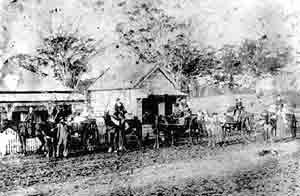The earliest reference to events in what is now the City of Blacktown is the first sighting of the Blue Mountains from Prospect Hill by Governor Phillip and his party in April 1788.
In July 1789 Captain Watkin Tench led a small exploratory party west from Prospect Hill to the Nepean River, on a route that approximates the Great Western Highway. The following year, Tench's second expedition in the area proceeded north-west of Prospect Hill, following a similar route to Riverstone that the railway line takes today. A third party led by Tench and Phillip explored the Upper Hawkesbury two years later, crossing the north of the district from South Creek to Toongabbie Creek.
Fourteen men received land grants from Governor Phillip in February 1792 for land at the base of Prospect Hill. Hardship forced nearly all of them off their farms in the next seven years. In 1800 better suited settlers arrived, and the area became more populated and prosperous.
At this time (1800), the district's first two roads were developed, one approximating today's Old Prospect Road, and the other the Old Windsor Road to Kellyville. More settlers moved along this second road, among them the prominent Pearce and Hume families in the Kings Langley area.
In 1802 Governor King reserved an area for a Government Farm, which approximates the boundaries of the Blacktown City area. This was known as the Government Stock Farm at Rooty Hill. In 1805 the area in the east of this land was proclaimed as a Common for the Prospect farmers. In the years to follow, the Blacktown district became a large grazing area for the Government's livestock.
On March 5 1804, the first major uprising of convicts on Australian soil took place. Convicts from Castle Hill escaped, hoping to join forces with convicts from Toongabbie and Parramatta, and to overthrow the military and take over the colony. Unfortunately for the Castle Hill convicts, their plans were not followed, and convicts from other places did not rise up with them. They were forced to flee westward, with the troops from Sydney quickly on their tail. At Rouse Hill the two groups met, and the ensuing battle saw between 20 and 40 of the convicts killed. This engagement became known as the Battle of Vinegar Hill, after an uprising of Irishmen against the British in Ireland some years previously.
After 1810 Governor Macquarie stared to grant large parcels of the Government Stock Farm. Most of the new landholders were army officers, senior officials and wealthy immigrants. Among them were O'Connell, whose grant "Riverston" gave the town Riverstone its name, and Major George Druitt after whom Mount Druitt is named. A number of land grants were made during the years 1817 to 1823, including grants to two Aborigines from the local Dharruk tribe. One of Council's major projects to celebrate the Australian Bicentenary in 1988 was the recreational reserve on Eastern Creek at Doonside named Nurragingy Reserve in memory of one of the Aborigines who received his grant along Richmond Road, Plumpton from Governor Macquarie in 1819.
There was also an effort to assimilate the Aborigines into European ways, with the building of the Native Institution at Plumpton in the 1820s. This little cluster of buildings became known as The Black Town, eventually giving the district its name. The Native Institution was not overly successful, and by 1833 it had been abandoned.
Moves were made to subdivide the original land grants in the area between the 1850s and 1860s. Settlements were clustered along the major roads - the Great Western Highway and Windsor Road. The Great Western Railway was extended beyond Parramatta in 1860, finishing at the Black Town Road. The first railway station was built on what was open space known as Prospect Common, and was imaginatively called "The Black Town Road Station". By 1862, this began to appear in official records as "Blacktown", and so it has remained despite several efforts to impose other names over the years.
The coming of the railway stimulated commerce and agriculture in the area, and more stations were added as the railway expanded west to Penrith and north-east to Richmond. The railway contributed to a land boom of the 1880s where thousands of allotments were created in subdivisions at Mount Druitt, Rooty Hill and Marsden Park.
While the railway enabled farmers to get their vegetables, fruit and poultry to market quickly, it also led to a timber industry which had soon wiped out the hardwood forests and associated wildlife. The district was now a thriving rural area: Plumpton was known as "the fruit growing capital of the Colonies"; Minchinbury was producing fine Australian wines; drovers brought cattle to Riverstone from all parts of the Colony; and orchards abounded with fruit at Seven Hills. Centres of populations grew around the railway stations and these towns became self-contained.

Main Street Blacktown, early 1900s
Click here for further information on the History of the Blacktown City